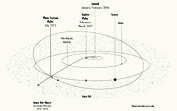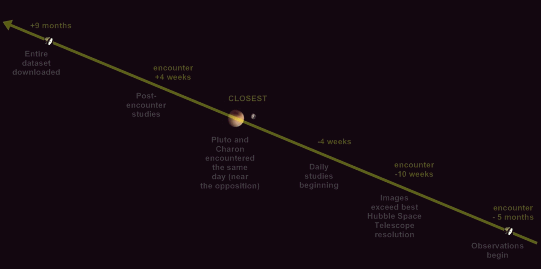 back Space
back Space![]() LATEST! After that the New Horizons mission sucessfully performed its flyby at Pluto on July 14th, 2015, its mission was extended into a mission towards the Kuiper Belt Object (KPO) 2014 MU69 and into the Kuiper Belt self, or the 'New Horizons Kuiper Belt Extended Mission' (KEM). The New Horizons flew by, like planned, 2014 MU69 on January, 1st 2019. check more with the New Horizons' Science in The Kuiper Belt link below! last updated Jan. 2nd, 2019
LATEST! After that the New Horizons mission sucessfully performed its flyby at Pluto on July 14th, 2015, its mission was extended into a mission towards the Kuiper Belt Object (KPO) 2014 MU69 and into the Kuiper Belt self, or the 'New Horizons Kuiper Belt Extended Mission' (KEM). The New Horizons flew by, like planned, 2014 MU69 on January, 1st 2019. check more with the New Horizons' Science in The Kuiper Belt link below! last updated Jan. 2nd, 2019
 | the encapsulated New Horizons mission is lowered onto the top of the Atlas V launcher |
Scheduled to launch in January 2006, NASA's New Horizons is a mission to Pluto. Pluto is the last of the planets of the solar system, and the last to have been discovered. It's Clyde W. Tombaugh, an enthusiastic amateur astronomer hired by the Lowell Observatory in 1928 to participate to continuing the quest for "Planet X", who discovered this faraway world which takes about 250 years to accomplish one of its orbits around the Sun. more about the discovery of Pluto. As, lately, new researches took the Kuiper Belt as an object of study, the status of Pluto in the solar system has been questioned. The Kuiper Belt, extending at the far reaches of the solar system is one of the reservoirs where comets are coming from, and a zone of leftovers of the solar system's formation. All what wasn't used to form the planets, found a place there, being a remnant of the primitive protoplanetary disk. Moreover, in January 2005, an object was found there to be larger than Pluto, with a size of 2,000 miles (3,200 km) across against 1,485 (2,390) for Pluto. Even if this body was too rapidly called the 10th planet of the solar system, the other studies about exoplanets are showing that the concept of solar system might have to be revised. The solar systems come into a variety of trajectories and distances. Another evidence is an object in another region of leftovers -the Oort Cloud- of our solar system, dubbed Sedna (with a diameter of 1,000 miles -1,600 km) which has been found in November 2004, and which may orbit the Sun -along its highly elliptical path- up to a distance of 84 billion miles (137 billion km), taking 10,500 years to complete one orbit! Such findings are pointing to the fact that our old solar system might well be, as a whole, just the central part of a more vast system where icy snowballs of the order of Pluto would circle the Sun at a little more than the distance of the latter and at much farther distances. Another way of seeing things is to say, that the "inner solar system" -up to Pluto- really is a solar system, as the other regions might be just zones of leftovers. The Kuiper Belt is lying from the orbit of Neptune up to 500 AU from the Sun as the Oort Cloud is beginning where the Kuiper Belt ends and it extends to 1, or maybe 2 light-years from the Sun. When NASA's New Horizons mission completes its study of Pluto in the summer of 2015, data from Earth will stream to the spacecraft to create a digital record that it will carry with it beyond the solar system
 | click to a view of the New Horizons mission trajectory. picture NASA |
In any case, it's the first time that a mission is departing to Pluto. No any spacecraft ever visited Pluto. Pluto was found to have a moon in the 1970s only. It's Charon. Lately, four additional, diminutive moons were found. Charon, along with these new moons will be part of the mission. New Horizons will shed light on Pluto and Charon's surface properties, geology, interior and atmospheres. Should NASA extend the mission, the spacecraft, after its flyby at the Pluto system, would continue into the Kuiper Belt, targeting two or more objects there of the size of 30 miles (50 km) in diameter. Such objects would be reached within two to three years and the object of such studies similar to those performed at Pluto and Charon
The mission is launching aboard a Lockheed Martin Atlas V, an Atlas booster -with five solid strap-on rocket boosters, with a Centaur upper stage and a Boeing STAR-48B solid-propellant rocket third stage (see a view of the structure of the Atlas V launcher, picture NASA with a detailed view of the phases of the launch, based on pictures NASA). New Horizons will be the fastest spacecraft launched ever, reaching the lunar orbit in 9 hours only, and Jupiter 13 months later! Despite such a speed, the arrival at Pluto will not occur before July 2015, after a gravity-assist flyby at Jupiter in February 2007. Should the launch not have occurred before Feb. 2, 2006, the craft would have missed the flyby opportunity and would have arrived at Pluto in 2020 only! The mission eventually launched on January 19th, 2006 at 2 p.m. EST (19h GMT). During its long journey to the far reaches of the solar system, New Horizons will "sleep" in electronic hibernation for much of the cruise, except the most critical electronic systems. The craft will be monitored once a year and checked out, as course corrections will be performed if necessary. New Horizons also features a radioisotope thermoelectric generator, or RTG
New Horizons has been designed and built at the Johns Hopkins University Applied Physics Laboratory, Laurel, Md.
more about the mission at the official site
New Horizons science payload consists of 7 instruments, three optical ones, two plasma ones, a dust sensor and a radio science receiver/radiometer
| Name | Abbreviation | Function | Developer(s) |
|---|---|---|---|
| Alice | - | Alice is an ultraviolet imaging spectrometer designed to probe the composition and structure of Plutoís atmosphere | Southwest Research Institute |
| Ralph | - | Ralph is a set of three panchromatic (black-and-white) and four color imagers. It will show how do Pluto and Charon's surfaces look like | Ball Aerospace Corporation, NASA Goddard Space Flight Center, Southwest Research Institute |
| Radio Science Experiment | (REX) | REX will use an occultation technique to probe Plutoís atmosphere and to search for an atmosphere around Charon. | Johns Hopkins University Applied Physics Laboratory, Stanford University |
| Long Range Reconnaissance Imager | (LORRI) | LORRI is a panchromatic high-magnification imager working on the basis of a 8.2-inch (20.8-centimeter) telescope. It will provide high-resolution pictures | Johns Hopkins University Applied Physics Laboratory |
| Solar Wind at Pluto | (SWAP) | This instrument will measure interactions of Pluto with the solar wind and the possible atmospheric escape at Pluto due to the feeble gravity of the planet | Southwest Research Institute |
| Pluto Energetic Particle Spectrometer Science Investigation | (PEPSSI) | PEPSSI is a particle spectrometer which will search for neutral atoms that escape Plutoís atmosphere and become charged by their interaction with the solar wind | Johns Hopkins University Applied Physics Laboratory |
| Student Dust Counter | (SDC) | Designed and built by students the SDC will detect microscopic dust grains produced by collisions among asteroids, comets, and Kuiper Belt Objects during the spacecraft's long journey | Laboratory for Atmospheric and Space Physics, University of Colorado at Boulder |

a view of New Horizons working plan. illustration site 'Amateur Astronomy' based on a picture NASA
| click to a New Horizons operations time schedule | click to New Horizons operations to Kuiper Belt object 2014 MU69 |
The mission of New Horizons is of the flyby type, that is that the craft will just fly by the planet. No probe, no landing, no capture in orbit. At its closest New Horizons will fly no closer than 6,200 miles (10,000 km) from Pluto and no closer than 16,800 miles (27,000 km) from Charon. The flyby will occur as the craft will be moving at a speed of 31,300 mph (50,300 km/h). The following scheme is showing how the mission will begin to study Pluto before the flyby strictly, as it will keep on after the flyby. Data will need about 4 hours, 25 minutes to reach Earth
Pluto is orbiting the Sun at an average distance of 3.7 billion miles (5.9 billion km), along a very elliptical and very tilted orbit. The planet is strangely tilted on its side, with its north pole 28° below the ecliptic. Pluto, with a diameter of about 1,466 miles (2,360 km) is roughly the two-thirds of our Moon. Pluto's surface composition includes nitrogen, carbon monoxide, methane and water ices as the interior is likely ice water and rocks. The planet has a tenuuous atmosphere mostly made of nitrogen, with traces of methane, carbon monoxide, and some heavier hydrocarbons. The upper atmosphere has a significant amount of free hydrogen. It might that Pluto's atmosphere endures extreme seasonal changes along the orbit. Estimated surface temperature is about -387 degrees Fahrenheit (-233 degrees Celsius). With a diameter of 745 miles (1,200 km), Charon, Pluto's main moon is sometimes considered like forming a "dual-planet system" with Pluto. It's orbiting at a distance of 12,201 miles (19,636 km) from the planet. Its surface might be water ice with some ammoniated hydrates as its interior is likely similar to that of Pluto. Charon has no atmosphere. As Charon is orbiting Pluto in the same duration than it rotates on itself (in 6.4 days) and as Pluto itself is rotating too in 6.4 days, Pluto and its moon are locked together. Pluto newly discovered moons, Nix and Hydra, are roughly 10-20% of Charonís size and they are orbiting two to three times farther from the planet
Website Manager: G. Guichard, site 'Amateur Astronomy,' http://stars5.6te.net. Page Editor: G. Guichard. last edited: 1/19/2015. contact us at ggwebsites@outlook.com